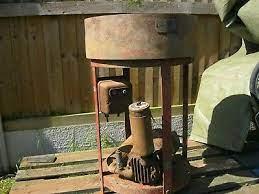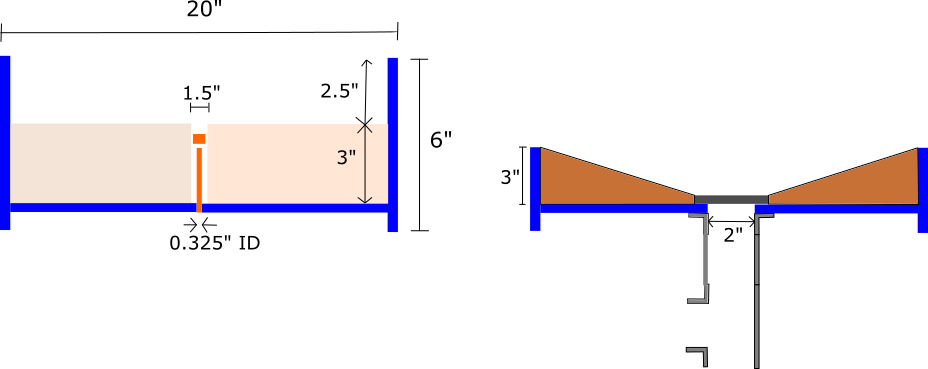
Frugal
Members-
Posts
7 -
Joined
-
Last visited
Profile Information
-
Location
South West UK
Recent Profile Visitors
The recent visitors block is disabled and is not being shown to other users.
-
I only had half a bag of lumpwood, so I used the briquettes to check that I could get the fire going and keep it going with the little fan I have. then I used the precious lumpwood for the actual forging.
-
Today I learned that blacksmithing without an instructor stood by you saying "hold it there", "hit is there", "turn it this way", is a lot harder My first solo attempt at an s-hook looks more like Salvador Dali's moustache
-
I have some 2" pipe fittings on order and they should hopefully turn up some time this week. I also have some coal being delivered on Monday, but I couldn't wait another week without at least trying her out. I gaffer taped an electric air bed pump to the air intake valve at the bottom and used some charcoal we had around the house. Please don't hate on me for the charcoal briquettes, we have precious little lumpwood left and I used the briquettes just to get the fire going (no one is selling lumpwood locally in Feb in the UK ). With a continuous airflow from the bed pump the fire is about 5-6" in diameter, and it never spread any wider than that no matter how much I encouraged it. It certainly got the hot spot hot enough to be able to get 8mm round stock hot enough to work, but I am never going to be able to make an axe or a hammer in it as it currently is. When I get it converted to a 2" airflow and a soil / dirt liner with a proper grate and the like I will give you an update. In the mean time I am going to continue to be very confused as to what kind of blower I need to get for this forge. I have been reading around the site, but I need to do some more digging as my head is full of CFM, PSI, Radial and Axial fans
-
I have managed to find a single image of the same forge that I have. Unfortunately it was a ghost of an old ebay sale, so I cant track down any more details. The looks to be identical to the one I have, same switching box, same blower with tall air filter. So it was definitely sold as I found it rather than being converted from something else. I wonder if it was not actually a blacksmiths forge, but some other kind of forge. Tinsmith or silver smith maybe?
-
I am trying to see if I understand you right. If the current set up is on the left, are you suggesting something like the setup on the right? Rather than dig out all of the existing brick, could I use a core drill to cut a 2" hole down through it, and then build up the top 2.5" with the soil that you suggest?
-
Thanks for the replies. The placard on the side of the forge says: "Alcosa - British Product" in the logo at the top. Then "William Allday & Co Ltd", "Stourport on Severn", "Worcestershire, England", "Pattern No B-011LB" The "drum" is 20" in diameter and the bricks are 3" thick and come up to 2.5" below the rim. The drum sits over the inlet blast, so when it is assembled the inlet pipe pushes up into the drum and the drum sits on the cross bar and the rim of the stand. So I think that the outlet works like a gas cooker hob, where it gets pushed out of the sides and up and around the "cap" of the inlet which is attached to the drum.
-
I have recently been given / inherited an old forge so that I can start blacksmithing. It is a William Allday & Co "Alcosa" forge. The main forging area is a 24" drum filled with 4 bricks of some kind, with a small air hole in the centre. Researching around, William Allday & Co were in business from 1948 to 1984, and the wiring had a green Earth wire, so it predates 1976 so this forge is at least 45 years old. Interestingly they are apparently unconnected to Allday & Onions, this was a separate Allday family (or at least a different branch of it. The air is supplied by a very old and very broken electric pump through a small 5/8" hole under the drum. There does not appear to be anyway of preventing clinker and ash building up in the hole in the drum, but as I was never able to see the forge in use it may "just work". The drum sits on the stand and the spigot the stands up on the stand frame pokes into the hols in the bottom of the drum. The inlet side of the spigot on the stand is only 3/8". The original motor was rated as 3.8CFM (0.1 m3/min). So this seems to be a low volume, high pressure kind of airflow rather than the standard forge setup which is high volume, low pressure. I did try to use a hair dryer to provide the airflow, but it died after about 30 seconds due to overheating as things like hair dryers are designed to do high volume, low pressure. When I look around for forge blowers, they are all 2-3" outlets, which makes me think that they are high volume, low pressure designs, so I am guessing that if I try to use one I will overheat it as I am not going to be able to push all of that air through the 3/8" tube. Has anyone seen / used this kind of forge? All of the other "Alcosa" forges I can find online have all had a large diameter blower on the side of the forge and are side blown. Does anyone have any recommendations as to what kind of air supply I should be looking for. I was thinking a small pump used to blow up inflatable beds, as they are low volume / high pressure, but I am not sure that any of them would be rated to run continuously for any length of time as they are only designed to run for a few minutes to blow up a bed. Once I can get a fire going, I will then look at some kind of hood and chimney so that I do not have to carry it outside to use it.

